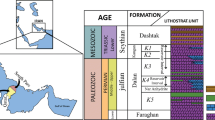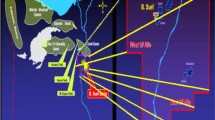Abstract
Accurate pore pressure knowledge is particularly critical in drilling, such as drilling safety (avoidance of blowouts and well control lost-time incidents). Pore pressure prediction in carbonate reservoir due to the fact that the pore system and fractures are more complex than the clastic reservoir, also the effectiveness of pore pressure on drilling parameters like weight on bit that has direct effects on drilling rate is very important. As well as, the pore pressure and rock strength parameters have a special place in geomechanical studies. In this study, pore pressure was calculated using the porosity and effective stress in the carbonate reservoir. The porosity was calculated with three methods: neutron–density, neutron–sonic and sonic. The rock strength parameters (Bulk and Shear modulus) were calculated using P and S waves obtained from dipole shear sonic imager log. The calculated pore pressure was compared with modular formation dynamics tester (MDT), WOB and rock strength parameters. The result of the study showed that among available methods, predicted pore pressure with sonic porosity has the best matched to MDT data. Moreover, pore pressure has an inverse relationship to WOB and rock strength parameters, so that with increasing pore pressure of both WOB and rock strength parameters were decreasing. The comparison among predicted pore pressure, mud weight and MDT data was showing that the predicted pore pressure has high accuracy and can use it for geomechanical studies and having a safe drilling operation.








Similar content being viewed by others
References
Bhagwan, S.; Singh, O.; Awadhesh, R.; Talukdar, B.: Occurrence of overpressures and its implications for hydrocarbon exploration. In: SPE India oil and gas conference and exhibition. Society of Petroleum Engineers (1998)
Fertl, W.; Chilingarian, G.: Importance of abnormal formation pressures (includes associated paper 6560). J. Petrol. Technol. 29(04), 347–354 (1977)
Hennig, A.; Yassir, N.; Addis, M.A.; Warrington, A.; Kravis, S.: Pore pressure estimation in an active thrust region and its impact on exploration and drilling (1998)
Holbrook, P.; Maggiori, D.; Hensley, R.: Real-time pore pressure and fracture gradient evaluation in all sedimentary lithologies. SPE Form. Eval. 10(04), 215–222 (1995)
Stephen, O.C.; Swarbrick, R.; Jenkins, S.; Green, S.; Clegg, P.: Modeling pore pressure profiles in carbonates. In: GEO 2010, p. cp-248-00189. European Association of Geoscientists & Engineers (2010)
Tang, H.; Luo, J.; Qiu, K.; Chen, Y.; Tan, C.P.: Worldwide pore pressure prediction: case studies and methods. In: SPE Asia Pacific Oil and Gas Conference and Exhibition. Society of Petroleum Engineers (2011)
Tingay, M.R.; Hillis, R.R.; Swarbrick, R.E.; Morley, C.K.; Damit, A.R.: Origin of overpressure and pore-pressure prediction in the Baram province Brunei. AAPG Bull. 93(1), 51–74 (2009)
Croizé, D.; Bjørlykke, K.; Jahren, J.; Renard, F.: Experimental mechanical and chemical compaction of carbonate sand. J. Geophys. Res. Solid Earth 115(B11), 1043–1063 (2010)
Goldhammer, R.: Compaction and decompaction algorithms for sedimentary carbonates. J. Sediment. Res. 67(1), 26–35 (1997)
Aharonov, E.; Katsman, R.: Interaction between pressure solution and clays in stylolite development: insights from modeling. Am. J. Sci. 309(7), 607–632 (2009)
Baker, P.; Kastner, M.; Byerlee, J.; Lockner, D.: Pressure solution and hydrothermal recrystallization of carbonate sediments—an experimental study. Mar. Geol. 38(1–3), 185–203 (1980)
Conybeare, D.; Shaw, H.: Fracturing, overpressure release and carbonate cementation in the Everest Complex, North Sea. Clay Miner. 35(1), 135–149 (2000)
Moore, C.H.; Wade, W.J.: Carbonate reservoirs: Porosity and diagenesis in a sequence stratigraphic framework. Newnes (2013)
Lucia, F.J.: Lower Paleozoic Cavern Development, Collapse, and Dolomitization. Franklin Mountains, El Paso (1995)
Moore, C.H.; Chowdhury, A.; Chan, L.: Upper Jurassic Smackover Platform Dolomitization Northwestern Gulf of Mexico a Tale of Two Waters (1988)
Dravis, J.J.; Muir, I.D.: Deep-burial brecciation in the Devonian Upper Elk Point Group, Rainbow Basin, Alberta, western Canada (1993)
Waples, D.; Couples, G.D.: Some thoughts on porosity reduction—rock mechanics, overpressure and fluid flow. Geol. Soc. Lond. Spec. Publ. 141(1), 73–81 (1998)
Bowers, G.L.: Pore pressure estimation from velocity data: Accounting for overpressure mechanisms besides undercompaction. SPE Drill. Complet. 10(02), 89–95 (1995)
Hottman, C.; Johnson, R.: Estimation of formation pressures from log-derived shale properties. AAPG Bull. 49(10), 1754–1754 (1965)
Eaton, B.A.: The equation for geopressure prediction from well logs. In: Fall Meeting of the Society of Petroleum Engineers of AIME. Society of Petroleum Engineers (1975)
Terzaghi, K.; Peck, R.B.; Mesri, G.: Soil Mechanics in Engineering Practice. Wiley, New York (1996)
Atashbari, V.; Tingay, M.R.: Pore pressure prediction in carbonate reservoirs. In: SPE Latin America and Caribbean Petroleum Engineering Conference. Society of Petroleum Engineers (2012)
Cao, Y.; Deng, J.; Yu, B.: Abnormal high formation pressure prediction and causes analysis. In: Proceedings of 2014 3rd International Conference on Environment Energy and Biotechnology, p. 5. CBEES (2014)
Azadpour, M.; Shad Manaman, N.: Determination of pore pressure from sonic log: a case study on one of Iran carbonate reservoir rocks. Iran. J. Oil Gas Sci. Technol. 4(3), 37–50 (2015)
Khamrat, S.; Archeeploha, S.; Fuenkajorn, K.: Pore pressure effects on strength and elasticity of ornamental stones. Scienceasia 42, 121–135 (2016)
Najibi, A.R.; Ghafoori, M.; Lashkaripour, G.R.; Asef, M.R.: Reservoir geomechanical modeling: In-situ stress, pore pressure, and mud design. J. Petrol. Sci. Eng. 151, 31–39 (2017)
Radwan, A.; Abudeif, A.; Attia, M.; Mohammed, M.: Pore and fracture pressure modeling using direct and indirect methods in Badri Field, Gulf of Suez, Egypt. J. Afr. Earth Sci. 156, 133–143 (2019)
Rahimpour-Bonab, H.: A procedure for appraisal of a hydrocarbon reservoir continuity and quantification of its heterogeneity. J. Petrol. Sci. Eng. 58(1–2), 1–12 (2007)
Esrafili-Dizaji, B.; Rahimpour-Bonab, H.: Carbonate reservoir rocks at giant oil and gas fields in SW Iran and the adjacent offshore: a review of stratigraphic occurrence and poro-perm characteristics. J. Pet. Geol. 42(4), 343–370 (2019)
Huffman, A.R.: Geophysical pore pressure prediction in complex geologic environments, offshore Libya. In: Offshore technology conference. Offshore Technology Conference (2013)
Wang, R.; Wang, Z.; Shan, X.; Qiu, H.; Li, T.: Factors influencing pore-pressure prediction in complex carbonates based on effective medium theory. Petrol. Sci. 10, 494–499 (2013)
Croize, D.; Renard, F.; Gratier, J.-P.: Compaction and porosity reduction in carbonates: a review of observations, theory, and experiments. In: Advances in Geophysics, vol. 54, pp. 181–238. Elsevier (2013)
Zoback, M.: Reservoir Geomechanics. Cambridge University Press, Cambridge (2007)
Zang, A.; Stephansson, O.: Stress Field of the Earth’s Crust. Springer, New York (2009)
Burchette, T.P.: Carbonate rocks and petroleum reservoirs: a geological perspective from the industry. Geol. Soc. Lond. Spec. Publ. 370(1), 17–37 (2012)
Atashbari, V.: Origin of overpressure and pore pressure prediction in carbonate reservoirs of the Abadan Plain Basin (2016)
Limited, S.: Log Interpretation Principles/Applications. Schlumberger Educational Services, Houston (1991)
Wyllie, M.R.J.; Gregory, A.R.; Gardner, L.W.: Elastic wave velocities in heterogeneous and porous media. Geophysics 21(1), 41–70 (1956)
Yu, H.; Rui, Z.; Chen, Z.; Lu, X.; Yang, Z.; Liu, J.; Qu, X.; Patil, S.; Ling, K.; Lu, J.: Feasibility study of improved unconventional reservoir performance with carbonated water and surfactant. Energy 182, 135–147 (2019)
Zhong, H.; Yang, T.; Yin, H.; Lu, J.; Zhang, K.; Fu, C.: Role of alkali type in chemical loss and ASP-flooding enhanced oil recovery in sandstone formations. SPE Reserv. Eval. Eng. 23(02), 431–445 (2020)
Khoshnevis-zadeh, R.; Soleimani, B.; Larki, E.: Using drilling data to compare geomechanical parameters with porosity (a case study, South Pars gas field, south of Iran). Arab. J. Geosci. 12(20), 611 (2019)
Goodman, R.E.: Introduction to Rock Mechanics, Vol. 2. Wiley, New York (1989)
Ameen, M.S.; Smart, B.G.; Somerville, J.M.; Hammilton, S.; Naji, N.A.: Predicting rock mechanical properties of carbonates from wireline logs (a case study: Arab-D reservoir, Ghawar field, Saudi Arabia). Mar. Pet. Geol. 26(4), 430–444 (2009)
Wang, Z.: Dynamic versus static elastic properties of reservoir rocks. Seism. Acoust. Veloc. Reserv. Rocks 3, 531–539 (2000)
Acknowledgements
The authors would also like to show their gratitude to the national Iranian drilling company for sharing the data of this research.
Author information
Authors and Affiliations
Corresponding author
Rights and permissions
About this article
Cite this article
Khoshnevis-zadeh, R., Hajian, A. & Larki, E. Pore Pressure Prediction and Its Relationship with Rock Strength Parameters and Weight on Bit in Carbonate Reservoirs (A Case Study, South Pars Gas Field). Arab J Sci Eng 46, 6939–6948 (2021). https://doi.org/10.1007/s13369-020-05284-x
Received:
Accepted:
Published:
Issue Date:
DOI: https://doi.org/10.1007/s13369-020-05284-x




